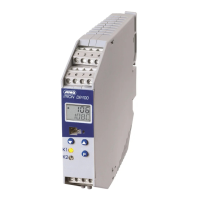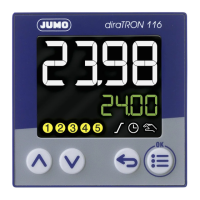4 Supplement
28
4.2.4 Ramp function and firing curve
Ramp function
This function allows the continuous change of the setpoint up to the ramp end value (setpoint
setting
SP1 or SP2). Depending on the actual value at ramp start, this results in a rising or falling
ramp with identical gradient (adjustable ramp ratio rASL).
Firing curve
For use in small kilns, a firing curve can be saved for controlled start-up and time-dependent
firing.
With this function, the parameters setpoint 1 (SP1), setpoint 2 (SP2), ramp rate (rASL) and timer
value (t1) are automatically linked to each other.
The ramp starts after mains ON (or through the binary
function) at time t1 and starts at the actual value. The set-
point SP1 (or SP2) is moved to at ramp ratio rASL and is
reached at time t2.
When switching over or changing the setpoint, the new
setpoint is also moved to at ramp ratio rASL.
The ramp can be stopped or aborted using the binary
function. When aborted, the setpoint setting SP1 (or SP2)
is used to control.
LED "Ramp“ (H): Is lit with active
ramp function (until it is cancelled)
TIP!
The ramp function is interrupted in the event of a probe break, probe short-circuit,
overrange/underrange or changeover to manual mode. Once the event is remedied
(or after switching to automatic mode), the ramp function continues at the current
actual value.
After the power supply is restored, the ramp function starts at the current actual
value.
Phase 1 (t1 to t2): The firing curve is started by using the
function key or with the binary function (time t1) and
starts at the actual value. The setpoint SP1 is moved to at
ramp ratio
rASL.
Phase 2 (t2 to t3): Once the current ramp value has
reached the setpoint
SP1 (t2), the device automatically
switches over to setpoint SP2 (w). The actual value (x)
approaches the new setpoint (the ramp ratio is of no
importance).
Phase 3 (t3 to t4): The timer starts when the actual value
has reached the setpoint SP2 (t3) and keeps running for
the set time (timer value
t1). Once the timer has elapsed
(t4), the controller switches off (setpoint display = 0).
LED "Ramp“ (H):
Flashes in phase 1,
is lit in phase 2 and 3

